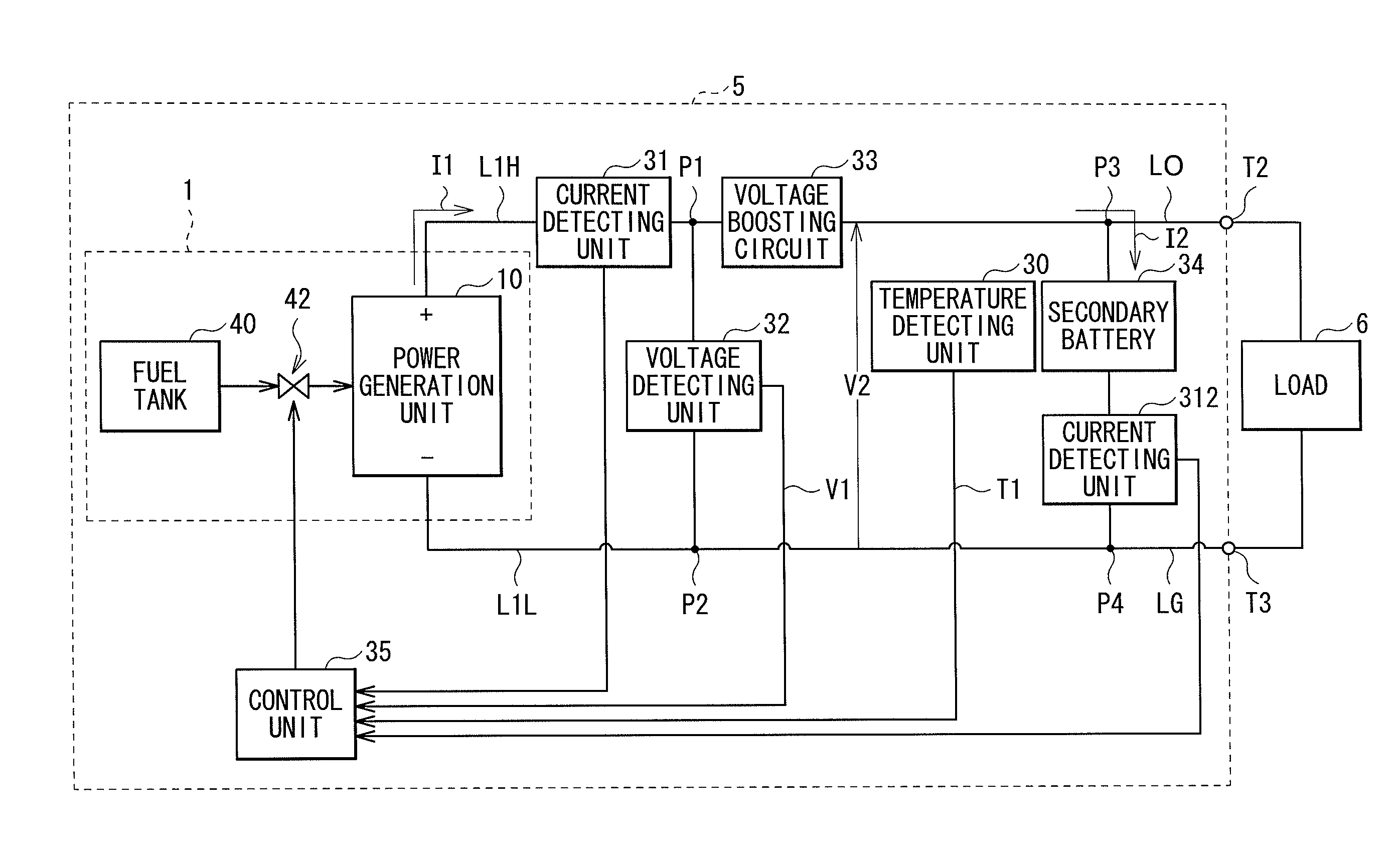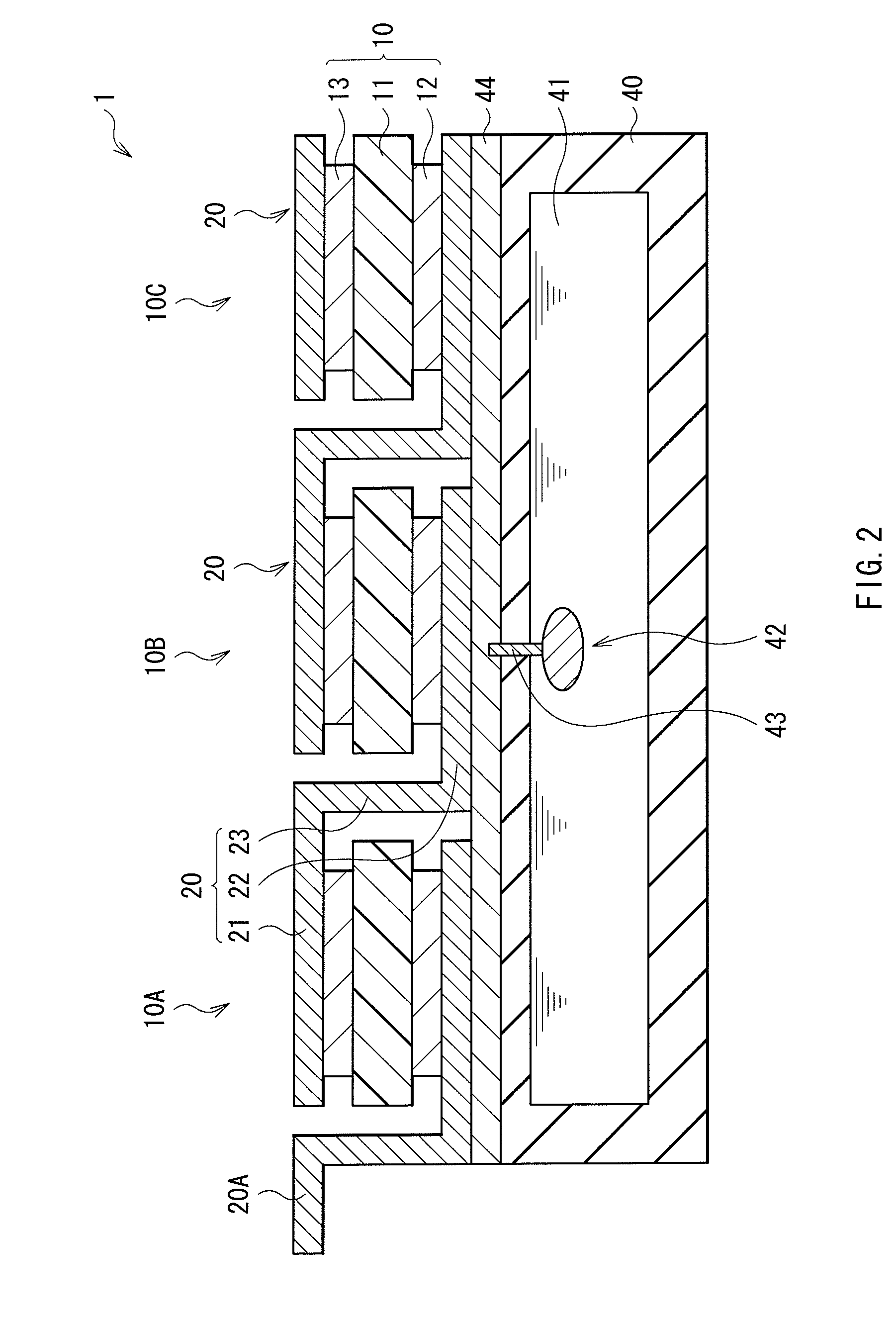Fuel cell system and electronic device
a fuel cell and electronic device technology, applied in the direction of secondary battery servicing/maintenance, battery/fuel cell control arrangement, electrochemical generators, etc., can solve the problems of secondary battery itself deterioration, rapid deterioration, increase in charge/discharge current for nominal capacity, etc., to suppress fuel cell deterioration, suppress secondary battery deterioration
- Summary
- Abstract
- Description
- Claims
- Application Information
AI Technical Summary
Benefits of technology
Problems solved by technology
Method used
Image
Examples
embodiment
Example of General Configuration of Fuel Cell System
[0025]FIG. 1 illustrates a general configuration of a fuel cell system (fuel cell system 5) according to an embodiment of the present invention. The fuel cell system 5 supplies power for driving a load 6 via output terminals T2 and T3. The fuel supply system 5 includes a fuel cell 1, two current detecting units 311 and 312, a voltage detecting unit 32, a voltage boosting circuit 33, a temperature detecting unit 30, a secondary battery 34, and a control unit 35.
[0026]The fuel cell 1 includes a power generation unit 10, a fuel tank 40, and a fuel pump 42. Note that the detailed configuration of the fuel cell 1 will be described later.
[0027]The power generation unit 10 is a direct methanol power generation unit which generates power by reaction between methanol and oxidant gas (for example, oxygen) and is constructed by including a plurality of unit cells each having a cathode (oxygen electrode) and an anode (fuel electrode). Note tha...
example
[0063]Here, FIG. 8 illustrates an example of the relations among the number of cycles (times), discharged capacity (mAh), and a thickness change amount ΔT (mm) in a lithium ion battery in the case of using a lithium ion battery as the secondary battery 34. In this case, two kinds of cycle tests are conducted: a cycle test of repeating 1C charge and 1C discharge (corresponding to “1C1C” in the diagram); and a cycle test of repeating 2C charge and 1C discharge (corresponding to “2C1C” in the diagram). The “1C charge (1C discharge)” denotes, for example, in the case where current capacity of a lithium ion battery is 1,000 mAh, charging operation (discharging operation) using charging current (discharging current) (that is, 1,000 mA) with which charging (discharging) is completed in one hour. Similarly, for example, in the case where the current capacity of a lithium ion battery is 1,000 mAh, “2C charge” denotes charging operation with charging current (that is, 2,000 mA) with which cha...
application example
2. Modification and Application Example
[0065]Although the present invention has been described above by the embodiment, the invention is not limited to the embodiment but may be variously modified.
[0066]For example, although the case of adjusting the supply amount of the liquid fuel by the fuel pump 42 on the basis of the generated current I1, the charging current I2, the generated voltage V1, and the temperature T1 of the secondary battery 34 which are detected in the control unit 35 has been described in the foregoing embodiment, the invention is not limited to the case. Concretely, for example, in the control unit 35, the supply amount of the liquid fuel by the fuel pump 42 may be adjusted on the basis of only the charging current I2 and the temperature T1 of the secondary battery as the minimum configuration.
[0067]Further, although the case where the control unit 35 controls so that the maximum charging current value Imax decreases exponentially as the detected temperature T1 of...
PUM
 Login to View More
Login to View More Abstract
Description
Claims
Application Information
 Login to View More
Login to View More - R&D
- Intellectual Property
- Life Sciences
- Materials
- Tech Scout
- Unparalleled Data Quality
- Higher Quality Content
- 60% Fewer Hallucinations
Browse by: Latest US Patents, China's latest patents, Technical Efficacy Thesaurus, Application Domain, Technology Topic, Popular Technical Reports.
© 2025 PatSnap. All rights reserved.Legal|Privacy policy|Modern Slavery Act Transparency Statement|Sitemap|About US| Contact US: help@patsnap.com



